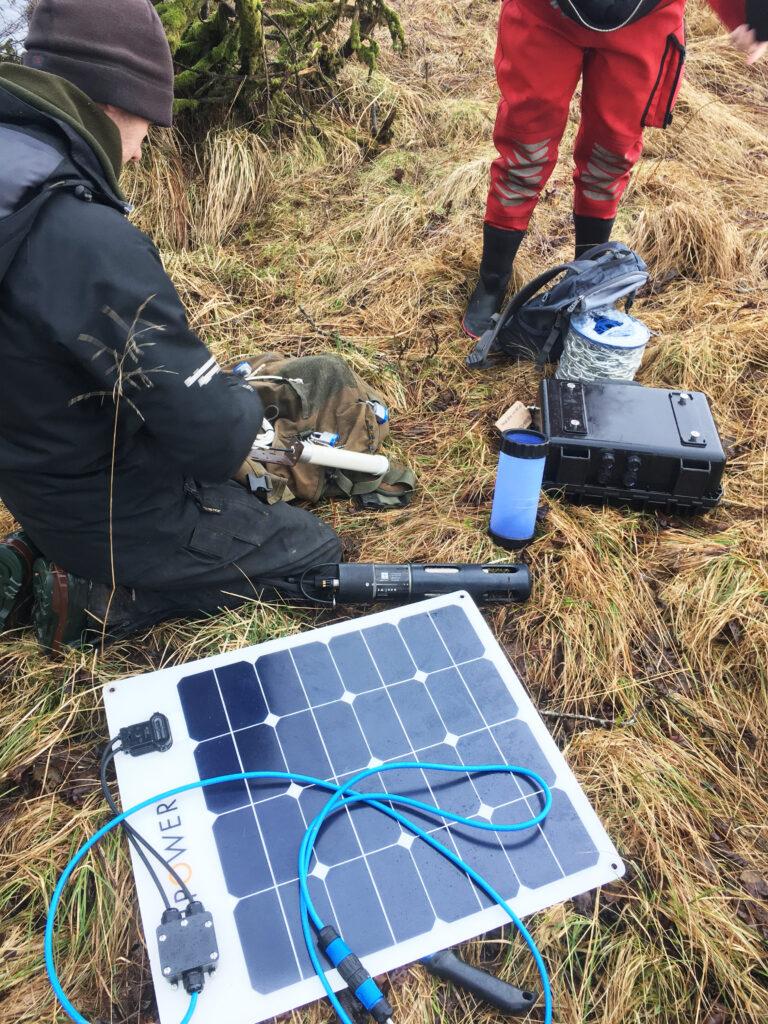Stella White, Environmental Monitoring Officer at the Environment Agency, explains the role of sondes and the research underway on the R4ever Kent project.

What is a sonde?
A sonde is a piece of equipment used to monitor water quality in situ. They can be fitted with sensors to measure multiple parameters, such as water temperature, pH, conductivity, and dissolved oxygen etc. Sondes can be deployed for long periods and can be programmed to measure at regular intervals, so long-term trends in water quality over time can be observed.
How do they work?
A typical site set-up includes the sonde, with the sensors immersed in the water; a battery powered black box (called an ESNET), which tells the sonde when to take the readings and records data; a solar panel to help recharge the batteries and, sometimes, an aerial to help transmit data if the signal in the area isn’t very good.
When a reading is taken, the sensors measure the water via different methods. For example, dissolved oxygen and turbidity are measured by optical sensors, which relate concentration to the intensity or scattering of light. pH and conductivity are measured by electrodes, and ammonium is measured by an ion-selective electrode – these sensors look at the change in an electrical potential created by the movement of ions. Data recorded by our sondes is plotted on a graph so we can see what the readings are almost as soon as they are taken.
What is the purpose of them?
Sondes allow us to gather a large volume of time-stamped water quality data; this can help to spot trends in water quality. Sondes are more likely to capture changes in water quality due to weather events or pollution events than traditional spot sampling. We can observe how certain water quality parameters change seasonally or with environmental conditions, which helps us to understand how water quality of a particular river or stream may respond to stressors.
How are sondes being used on the project?
The LIFE R4ever Kent project has three sondes deployed around the Kent catchment on different rivers. These sondes are providing us with a background of water quality in the uplands of the Kent catchment. This could act as a baseline to aim for when undertaking restoration work as part of the project.
The project sondes are set up to take hourly measurements of:
• Temperature
• pH
• Conductivity
• Turbidity
• Dissolved Oxygen
• Ammonium (NH4+)
• Chlorophyll
• Blue Green Algae – Phycocyanin
An estimate of the concentration of unionised ammonia (NH3) is also calculated using the measured ammonium concentration and other environmental parameters such as temperature and pH.
How do you check them?
Data recorded by each sonde are plotted on a graph as measurements are taken. These graphs are checked regularly for any trends or patterns, or changes in data quality. If something looks unusual a member of the project team can visit the site and check the equipment. Sonde data are available online via the Meteor Data Centre.
How often do you check them?
The sensors also need to be re-calibrated to prevent ‘drift’ (the consistent under or overestimate of concentrations) and to ensure that they are still functioning correctly. Rather than trying to calibrate sensors in the field, we swap the sonde for one with calibrated sensors and send the ‘old’ sonde for re-calibration.
The frequency of calibration depends on the concentrations that the sonde is exposed to; if the sensors are measuring very high concentrations, then they will need to be calibrated more often than if only low concentrations are measured. As the sondes used for the LIFE R4ever Kent project are measuring relatively low concentrations in freshwater, they do not need to be calibrated so regularly; currently they are calibrated every three months.

Do you ever have any issues with the sondes?
Using sondes allows us to gather much higher frequency water quality data than traditional spot sampling, meaning we can identify trends or events which may otherwise be missed. That said, sondes do also come with some issues.
Sondes deployed in the field are subject to the elements. Sondes could be damaged during high flows or can come out of the water if levels are low. The sondes can also be clogged with debris such as leaves in autumn or plant growth in summer – this is why it’s important to monitor the data as it is recorded and visit sites if anything looks a little odd or unexpected.
Our sondes are battery powered, with a solar panel to help recharge those batteries. As you could expect in a Cumbrian winter, sunshine is limited, so batteries do occasionally have to be changed when they run flat.
As with any technology, sometimes things stop working for unknown reasons. Thankfully, we have a very helpful team at the Environment Agency (the National Water Quality Instrumentation Service) who are on hand to help with fixes or send out replacement kit.

